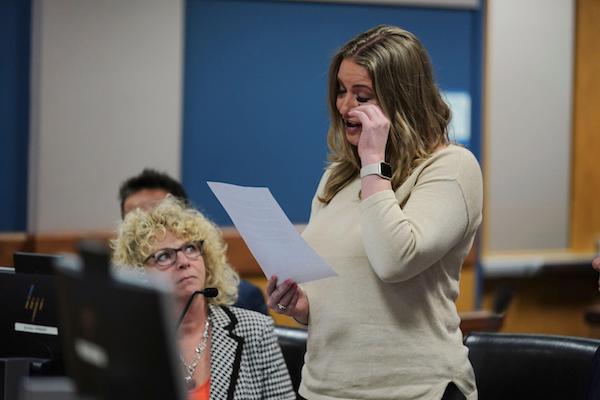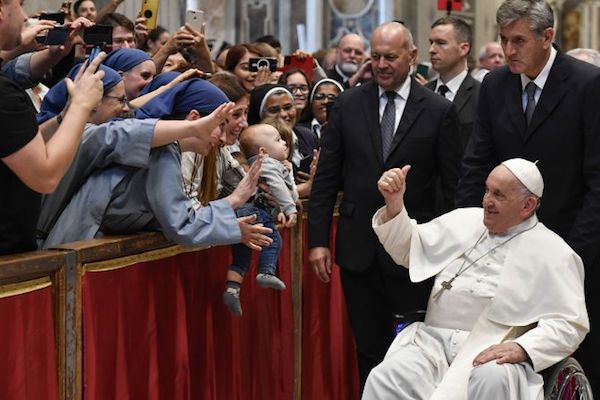The document released at the conclusion of the first of the two-part climax to the Synod process points toward a profound shake-up of the Church. Its proposals include an expanded role for women in ministry, making lay involvement in decision-making mandatory, an overhaul of the seminary system, and a revision of the Church’s Code of Canon Law. On women deacons, the Synod agreed that this issue needs more discernment and asked that the findings of previous papal commissions on the issue be presented to the concluding assembly in October 2024.
It was never expected that this October’s synod would hone in on the most contested topics in the Church and make dramatic proposals. This was only the first round of a synod double-header, which began at the local level two years ago. “Today, we do not see the full fruit of this process, but with farsightedness, we look to the horizon opening up before us,” Pope Francis said in his homily at the Mass concluding the assembly in St Peter’s Basilica.
The breakthrough achieved by the Synod was not to be found in the texts focusing on particular issues but in the widespread acceptance of the ways of discussing and discerning that were adopted at this Synod for the first time. The radically different approach encouraged attentive and prayerful listening among small groups of cardinals, bishops, priests and lay people seated around tables. All 350 or so members of the Synod were able to speak, each of them being allotted the same time. The process led to the unprecedented sight of cardinals from the Roman Curia sitting at round tables with women from Asia and Latin America. “It was a levelling of the participants,” one delegate explained.
The prophets of doom who had warned of a conspiracy to overturn church doctrine and had predicted a schism, or a descent into irreconcilable polarisation, were proved wrong. Each paragraph of the final “synthesis document” was voted on in turn, and all received the approval of at least a two-thirds majority. Several bishops who had voiced concerns or had been openly sceptical of the synod were won over by the new process.
Every Christian denomination is experiencing deep divisions in recent decades, particularly over the recognition of same-sex relationships. What is remarkable about the way this issue is being discussed in the Catholic Church is how – so far, at least – the synodal process has established a container that is both holding disagreements and – at the same time – building communion. There is considerable tension, but the container is succeeding in balancing a more inclusive conversation with the authority of the papacy.
“The real miracle is the overwhelming agreement that synodality is the way of proceeding in the Church,” the Canadian Cardinal Michael Czerny told me as we walked together past the Swiss Guards and up to the side entrance of St Peter’s Basilica for the closing synod Mass last Sunday. The cardinal, a Jesuit, is the leader of the Holy See’s office for integral human development and has worked in Africa, Central America and North America. “Going into the synod was like walking into a laboratory,” he said. “We were testing something, and it wasn’t clear if it was going to work. But the test results are encouraging. This can no longer be dismissed as a fashion or a fad. Synodality – a way, a style of walking together – is what the Lord expects of the Church in the third millennium.”
The inclusion of women – there were close to as many women present as voting delegates as there were cardinals – was also groundbreaking. The presence of lay people led to relentless questioning from critics of the Synod – and sometimes from bishops speaking in the Paul VI Hall – of the status and authority of the Synod, and whether it could still be called a “Synod of Bishops”. According to the final report, some still want to reserve membership of the Synod to bishops, and it was acknowledged that the “criteria by which non-bishop members are called to the assembly” should be clarified. Given the particular role bishops have as teachers and successors to the Apostles, some proposed that the “ecclesial assembly” of bishops and lay people should be followed by a separate “episcopal assembly” to conclude the process of discernment.
The Synod remains a consultative body, as it has been since it was established by Pope Paul VI during the fourth and final session of the Second Vatican Council. The Pope has the final say. Bishops don’t operate in isolation, and the success of the assembly showed that their discernment is helped by the presence of priests and lay people as well as fellow bishops. The process is a development from the structure established by Paul VI but, as the Australian theologian Ormond Rush pointed out in a well-received address in which he quoted extensively from Joseph Ratzinger, tradition is dynamic rather than static, legalistic and ahistorical.
One source close to the synod proceedings put it this way: “The progressives got the process, and the conservatives got the content.” The final document did not use the term “LGBTQ Catholics” (as the working document had), despite the shift in pastoral approach the Pope has modelled over the last decade. “I would suspect that most LGBTQ Catholics will be disappointed that they are not even mentioned in the final synthesis,” Fr James Martin SJ, the Jesuit priest who has a high profile ministry to gay Catholics, said afterwards. “The document, as it turns out, does not reflect the fact that the topic of LGBTQ people came up repeatedly in both many table discussions and the plenary sessions, and provoked widely diverging views.” Nevertheless, Fr Martin stressed that the Synod was a “great grace” and that it “hasn’t finished yet”.
While gay and lesbian Catholics were not expressly mentioned, the synthesis document acknowledged that that the Church’s “anthropological categories” when it comes to sexuality and identity had not adequately taken into account human experience and the sciences. That is a significant admission, and it opens the door to what could be a wide-ranging reimagining of Catholic teaching on sexuality.
How the LGBTQ question was handled reflected a Church that is no longer dominated by Europe and the west, but one which is multi-polar and where the global south is growing in influence. We also saw this in the agreement that bishops in Africa should promote a “theological and pastoral discernment” on the question of polygamy, including how to accompany those in polygamous unions. Discussions of the Church’s ministry to Catholics in same-sex relationships were at times tense. At one point, the delegates heard the powerful story of a young woman from Poland who took her own life because she was bisexual and did not feel welcomed into the Church. Sources also told me that one high-ranking Eastern Catholic prelate refused to sit at the same table as Fr Martin.
Although the synthesis document steers away from topics where agreement wasn’t possible, it includes a series of potentially significant proposals. One is that the system for the training of priests in seminaries should undergo a “thorough review” in light of the Church’s “missionary and synodal dimensions”. It calls for programmes where lay and ordained are formed together, that candidates for ordained ministry need to experience living in a Christian community before entering a seminary, a greater integration of women in the seminary system and that formation houses should not create an “artificial environment, separate from the ordinary life of the faithful”.
On the question of accountability, the final document suggests that bishops undergo performance reviews to assess how they exercise authority and manage finances and that “priests and deacons” undergo a “regular audit” of how they are carrying out their role. There is also a proposal to consider the“re-insertion of priests who have left the ministry in pastoral services” on a case-by-case basis, and to give “further consideration” to the ordination of married men.
What a more synodal church looks like regarding church law and structures still needs to be studied. The synod proposed that an “intercontinental special commission of theological and canonical experts” be established to work on proposals ahead of next year’s assembly. The final document also called for pastoral councils, bodies including the non-ordained and the clergy, to be made obligatory at the parish and diocesan levels.
While the Synod was a transformative experience for the several hundred bishops, priests and lay people involved, the real test of its success will be the extent to which synodality is taken up at parish, diocese and national level. While several local churches have taken up the synodal initiative, plenty more have simply ignored it. The most “No” votes came for the paragraphs on female deacons, while the section calling for “further consideration” of mandatory celibacy for priests also received a substantial number of “Nos”.
The Synod took place against the backdrop of the unfolding war between Israel and Hamas and Russia’s continuing war in Ukraine. Later this month, world leaders will gather in Dubai for the latest COP gathering to address the climate crisis (Francis is tipped to join them). It is within this context of war, conflict and fragility that the Church has to carry out its mission. As the Synod concluded, Francis said the Church must put God and service before personal agendas. “This is the Church we are called to ‘dream’: a Church that is the servant of all, the servant of the least of our brothers and sisters,” he said. “A Church that never demands an attestation of ‘good behaviour’, but welcomes, serves, loves, forgives; a Church with open doors that is a haven of mercy.”
The second and concluding session of the Synod on Synodality will be held in the Vatican in eleven months’ time. It will be vital for the realisation of Francis’ “dream” that the work continues and the momentum created by the first session is sustained. But the synodal and missionary Church is already emerging.



 Loading ...
Loading ...